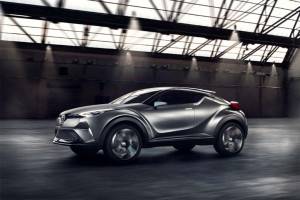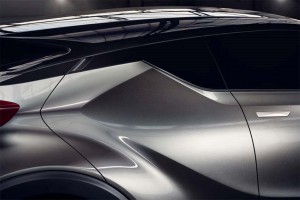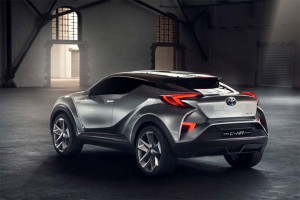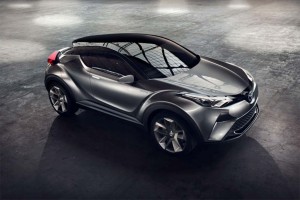Toyota is driving into Frankfurt with a new small crossover and a new design language.
A year after unveiling the original C-HR concept, the Japanese maker is back with an updated design that appears to be a step closer to production. The updated version of the Toyota C-HR also appears to help the Japanese maker pull together in a cohesive whole some of the design details it has been showing off in other recent offerings, including the new Camry and Corolla models.
“This highly innovative design study for a stylish, lightweight and dynamic hybrid crossover is designed to stand out in an increasingly homogeneous marketplace,” Toyota declared in a release describing its plans for the 2015 Frankfurt Motor Show.
It describes the 5-door C-HR’s styling as part of its new “diamond-shaped” design language. And that seems to fit the angular and crisp-edged concept vehicle. The theme extends from the broad air intakes of the front fascia to the unusual kick-up of the rear quarter panel, and even to the “diamond-cut” spokes of the show car’s 21-inch wheels.
(Click Here to check out the all-new 2016 Toyota Prius.)
The hatchback’s rear glass tapers down aggressively, flowing into a more muscular lower body than the typical hybrid. That sporty theme is underscored by the bold front grille and broad wheel arches.
The basic shape has a lot in common with the new Lexus NX crossover. But under the skin, the C-HR shares the Toyota New Generation Architecture, a platform that will now be used for a wide range of offerings, including the all-new Prius hybrid that will get its first public showing in Frankfurt this week.
Toyota was notably silent about the drivetrain in the 2016 Prius, other than promising it will deliver a 10% boost in fuel economy. With the C-HR, the maker suggests it is motivated by a “new, advanced, full-hybrid powertrain (that) offers a uniquely engaging driving experience matched to 21st Century driving conditions.”
Again, Toyota is holding back details, hinting only that the C-HR’s drivetrain is smaller than the familiar Hybrid Synergy Drive, taking advantage of “advances in battery, electric motor and petrol engine technology.”
References to “state-of-the-art battery technology” could mean that Toyota is finally moving away from the time-tested, albeit dated, nickel-metal hydride batteries it has stuck with in the Prius and other hybrid models. Whether C-HR jumps to lithium-ion or even more advanced technologies, such as lithium-air or even a solid-state battery remains to be seen.
A statement from the automaker promises the powertrain package will be smoother, easier to drive than Toyota’s current hybrid technology.
(Patent filing hints Toyota may be working on a flying car. Click Here for more.)
With Europe the biggest market for compact crossovers, Toyota Motor Europe is playing lead in the development of the C-HR, though its designers had to win a shoot-out with Toyota colleagues in other parts of the world.
While Toyota is being coy about specifics, not yet confirming whether the latest C-HR concept will move on to production, the maker is clear that it has every intention “to enter the C-crossover segment,” most likely within the next couple years, sources indicate.
(Toyota adding hybrid version of RAV-4 EV. Click Here for more.)





Toyota must have been reading Nissan’s Puke press releases. It’s tough to decide which design is the worst because they are both so bad.